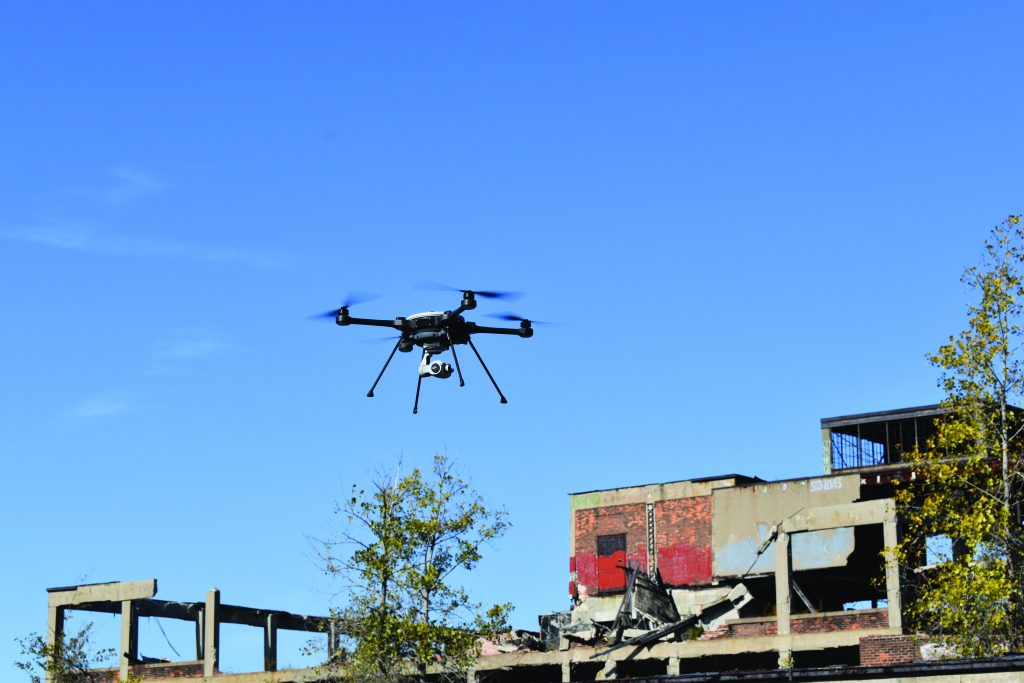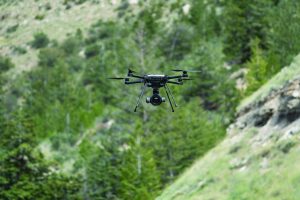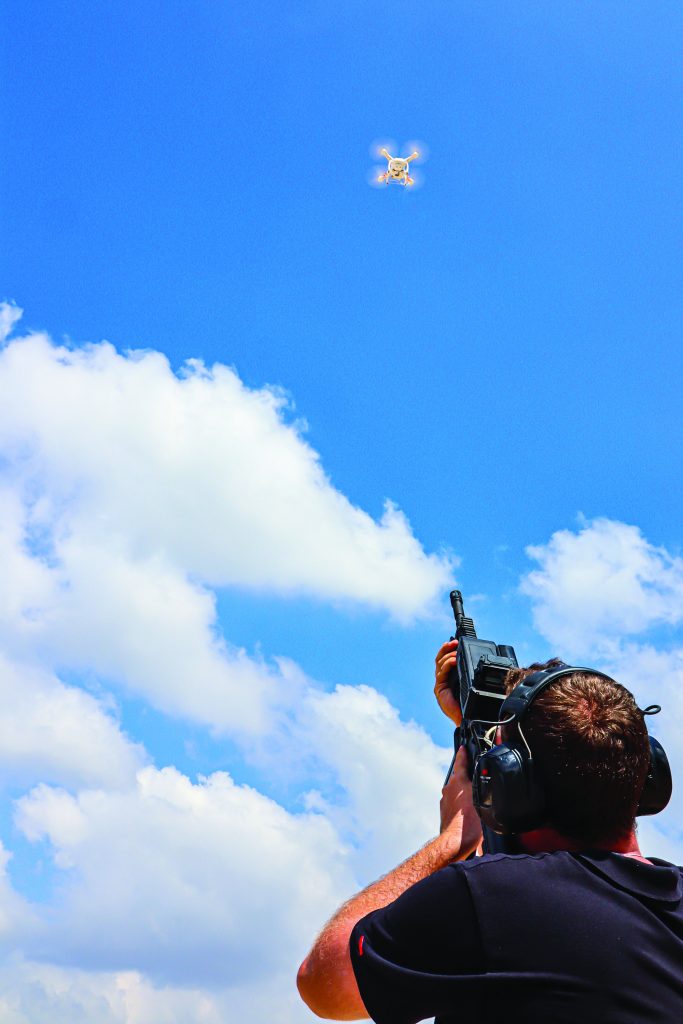
The usage of unmanned aerial systems (UAS) has been on the rise by federal, state, and local law enforcement since its implementation into the profession over a decade ago. Informally known as drones, law enforcement officers first utilized these systems for surveillance, crowd monitoring, and search and rescue operations.
In many states, however, legislators imposed restrictions on drones that agencies must abide by when implementing a drone program.
These restrictions may have caused a standstill in some drone programs, but companies invested in creating UAS continued to think creatively to provide innovative solutions that are compliant with the Federal Aviation Administration’s regulations. “Before, our customers were limited to traditional needs, which involved either manned aviation or ground-based technology,” said FLIR Systems’ vice president of UAS product development David Proulx. “As we continue to innovate in technology, we are now making those tasks, safer, faster, and able to be accomplished in a broad range of environments.”1
Due to customer needs, providers of drones unlocked new ways for officers to utilize the systems. Drones have been authorized for use in 90.82 percent of search and rescue operations, 83.67 percent of incidents involving investigating armed and dangerous subjects, 80.61 percent of traffic collision reconstructions, and 68.37 percent of incidents regarding bombs and hazardous materials observation. Other uses of drones in policing include hostage negotiation, K9 backup, disaster response, as well as supporting officers serving warrants and investigating armed and dangerous suspects.2
Systems
For over 10 years, the Wilsonville, Oregon-based FLIR Systems, Inc. (FLIR) has remained unique in the unmanned systems realm because of their catalogue of UAS, as well as unmanned ground systems or robots.
“When we started, UAS were in limited usage because they were complex to operate, they required dedicated specialist personnel, and they were also limited in when and where they could be used,” explained Proulx. “So we deliberately set out from the very beginning of our investment of UAS to make [solutions] that could be used as a collateral duty by a front line officer … and it could be used in any environment.”

Their primary product offering commonly used by law enforcement is the SkyRanger R70. Developed for the most demanding UAS operators within the defense, security, and public safety markets, the SkyRanger R70 established a new benchmark for small UAS performance and reliability.
Although it is a smaller system, the SkyRanger R70 has a ground speed of 31 mph and boasts over 40 minutes with standard propulsion systems. With a carbon fiber and magnesium airframe, the R70 can withstand sustained winds of up to 40 mph and gusts of 56 mph while in flight. R70 operators can attach, carry, and deliver nearly any object up to 4.4 lb.—such as radios, ground sensors, and medical kits—for forward resupply, asset extraction, or other specialized missions.
The R70 also features a robust digital MMO communications link and two independent navigation subsystems. The systems can execute semi-autonomous missions without an active wireless link for operations in denied radio frequency environments.
Implementing a Program
Introducing the appropriate drone program into an agency can be a difficult process. Luckily, there are companies such as Mission Critical Partners (MCP), that can ensure the proper program is implemented to best serve the agency’s needs.
Although the market for drones in public safety is still relatively new, agencies are beginning to adopt drone technology at an increasing rate to enhance their emergency response operations. Darrin Reilly, chief operating officer of Mission Critical Partners, said, “As more and more use cases emerge, it has become evident that having a drone program in place can help improve the efficiency and effectiveness of emergency response operation and save more lives.” He also mentions that it is crucial that agencies understand not only the technology but also the myriad regulations that stand in the way of creating a drone program.3
“It is crucial that agencies understand not only the technology but also the myriad regulations that stand in the way of creating a drone program.”
Headquartered in Port Matilda, Pennsylvania, Mission Critical Partners helps public safety agencies navigate local, state, and federal regulations around the use of drones; conduct extensive research; provide recommendations on drone specifications, training, and use cases; and work with agencies to develop a program that will best work for them.
MCP’s subject matter experts leverage their knowledge of drone technology and regulations, coupled with their personal experience as emergency responders, to help agencies build a program that will meet their needs, along with the needs of the communities they serve.
MCP works with agencies to identify the needs and expectations for their drone program, as well as the potential roadblocks to program launch, including personnel or budgetary limitations. From there, the team of subject matter experts conducts extensive research on the regulations that will impact the specific agency. The final deliverable is a roadmap for standing up the agency’s drone program, which includes drone specifications, training recommendations, and use cases. The roadmap will also provide a plan for meeting regulatory guidelines.
“It is a worthwhile investment to find a partner to help navigate the regulatory environment and help work through the different technologies available to stand up the best program for your agency,” said Reilly.
Counter-UAS Solutions
Even though having a drone program brings many benefits to the law enforcement profession, new UAS technology has also brought about a new threat. In recent years, there has been an uptick in malicious use of UAS, enabling hostile forces to gather critical tactical intelligence and even make direct attacks. Because these unmanned aircrafts are fast and nimble, they are hard to counter even for skilled marksmen.
The Yagur, Israel-based Smart Shooter’s fire control solutions have introduced the Smash family of products into the military and public safety professions. “[These solutions] are designed to give law enforcement officers a decisive tactical edge in almost every operational scenario, maximizing operational effectiveness throughout every engagement while keeping the force safe and making sure that innocent civilians are not accidentally getting hit,” said Smart Shooter chief executive officer Michael Mor.4

Smash Fire Control System is an external add-on solution that can be integrated onto any type of assault rifle, providing law enforcement professionals with an advanced system to support mid- and long-range engagements. Once the user identifies the drone threat, Smash tracks its movements and synchronizes the shot release to ensure precise hits on the target.
Significantly reducing operating costs, training hours, and amounts of ammunition, the Smash fire control system is a cost-effective solution. Smash offers a precision anti-drone capability, featuring built-in targeting algorithms that can track and hit even small drones skimming at high speeds at ranges of up to 250 meters. With a “One Shot—One Hit” capability, the solution allows the operator to quickly and effectively neutralize any unmanned threat.
Smash creates a micro-tactical network between deployed Smash units, enabling system “cross-talk” and ensuring a common operational picture is shared.
The counter-UAS technology can be seen in the Smash 2000 Plus. It includes the entire set of Smash fire control solutions with an additional counter-UAS mode. The Smash 2000 Plus proprietary target acquisition and tracking algorithms are integrated with sophisticated image-processing software into a rugged hardware solution.
As drone technology continues to expand, it is important for companies invested in drone products to create innovative additions to their catalogs for the public safety sector. David Proulx said, “When we look to the future, what our customers our starting to [ask] now is ‘Well how do we use all this technology together in an easy way to help us accomplish these tasks faster and more safely?’”
Notes:
1David Proulx (vice president of UAS product development, FLIR Systems, Inc.) phone interview, July 31, 2020.
2Police Executive Research Forum, Drones: A Report on the Use of Drones by Public Safety Agencies—and a Wake-Up Call about the Threat of Malicious Drone Attacks (Washington, DC: Office of Community Oriented Policing Services, 2020).
3Darrin Reilly (chief operating officer, Mission Critical Partners) email interview, July 23, 2020.
4Michael Mor (chief executive officer, Smart Shooter) email interview, Jul 28, 2020.
|
Source List ■ Cape Aerial Telepresence
|


